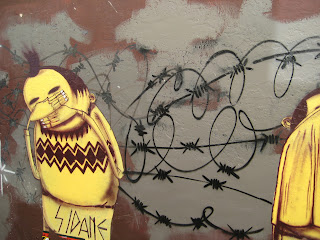Meeting in the wee hours (those 8.30am awakenings are a killer) we retraced our steps from UTS to Foley St, then spent some time wandering about the area, heading down interesting laneways or following our senses to curious details in the urban environment – a kind of flanerie of the area, expanding our senses to absorb the feeling of the place and take note of overlooked details, as well as the kind of people as well and volume of people around at the time, the type of businesses and the overall atmosphere.
While wandering, I was struck with the relaxed feeling of the other laneways around the Foley St area, which were not actually dead and deserted but filled with vibrant detail – small street art pieces and artistic graffiti splashed across the brickwork added character to the space, as did quirky stickers and tags, but most surprising was the proliferation of greenery. Above all – the elegance of tufts of plant life penetrating the cracks of mortar and claiming their rightful place in the urban streetscape.
In many lanes, pot plants and gardens bloomed, and we were awed when we came across a small residency on a lane completely overgrown with vines and greenery across the façade, inspiring us to touch and appreciate. The insurgence of nature also extended into small weeds and plants popping seemingly out of nowhere, growing admist a concrete jungle.
 |
| Lush greenery enveloping the facade of a laneway residence |
This visual journey through the area has proved very fruitful in stimulating ideas for potential situations, and as we discussed afterward, we were all drawn towards ideas revolving around nature and the city – bring back nature and greenery, promoting growth – much as we would like to take an empty, dead lane like Foley and see it bloom anew.
Discussing our observational and sensory finding in the charming Commons eatery afterward, we all agreed that the presence of nature in the laneways surrounding Foley was something that really impacted, and would be a great basis for a concept strongly based in the area and relevant to the Foley St endeavor – the return of nature to urban spaces.
We also had an enlightening discussion with the owner of the Commons, who came from a background of landscape architecture and sustainability himself and whole-heartedly supported our aims, giving us some helpful pointers and advice: ‘It’s about doing the maximum with the minimum.’
With a firm handle on our primary research and burgeoning concept, we next turned to secondary sources to find further inspiration and generate new ideas. One installation art example we looked at was ‘Head Gardeners’, a series of guerilla artworks by Anna Garforth in London. These artworks consisted of recycled plastic containers painted with playful, comical expressions, which acted as vessels for a range of living plant life. This work was displayed in accessible locations around London streets, emphasizing the message about bringing the role of nature within the city structure to attention.
 |
| 'Head Gardeners' (The Instablogs Network, 2010) |
 |
| 'Head Gardeners' (The Instablogs Network, 2010) |
Anna Garforth has also worked on other collaborative street art projects which the same theme, such as ‘Rethink’ and ‘Nourish’, which are graffiti-style words created on a large scale using materials like leaves and moss. These words are statements, aimed at changing attitudes about the environment and forcing viewers to analyse modern consumer behavior.
 |
| 'Rethink', created with leaves stapled to the fence (designboom, 2010) |
 |
| 'Nourish'; ecological graffiti, created from moss in collaboration with Eleanor Stevens (designboom, 2010) |
REFERENCE LIST
Justa, A., 2010, Anna Garforth promotes green with thought provoking eco-graffiti, The Instablogs Network, viewed on 5/9/2010, http://www.greendiary.com/entry/anna-garforth-promotes-green-with-thought-provoking-eco-graffiti/
2010, Anna Garforth, designboom, viewed on 5/9/2010, http://www.designboom.com/weblog/cat/8/view/10993/anna-garforth.html










No comments:
Post a Comment